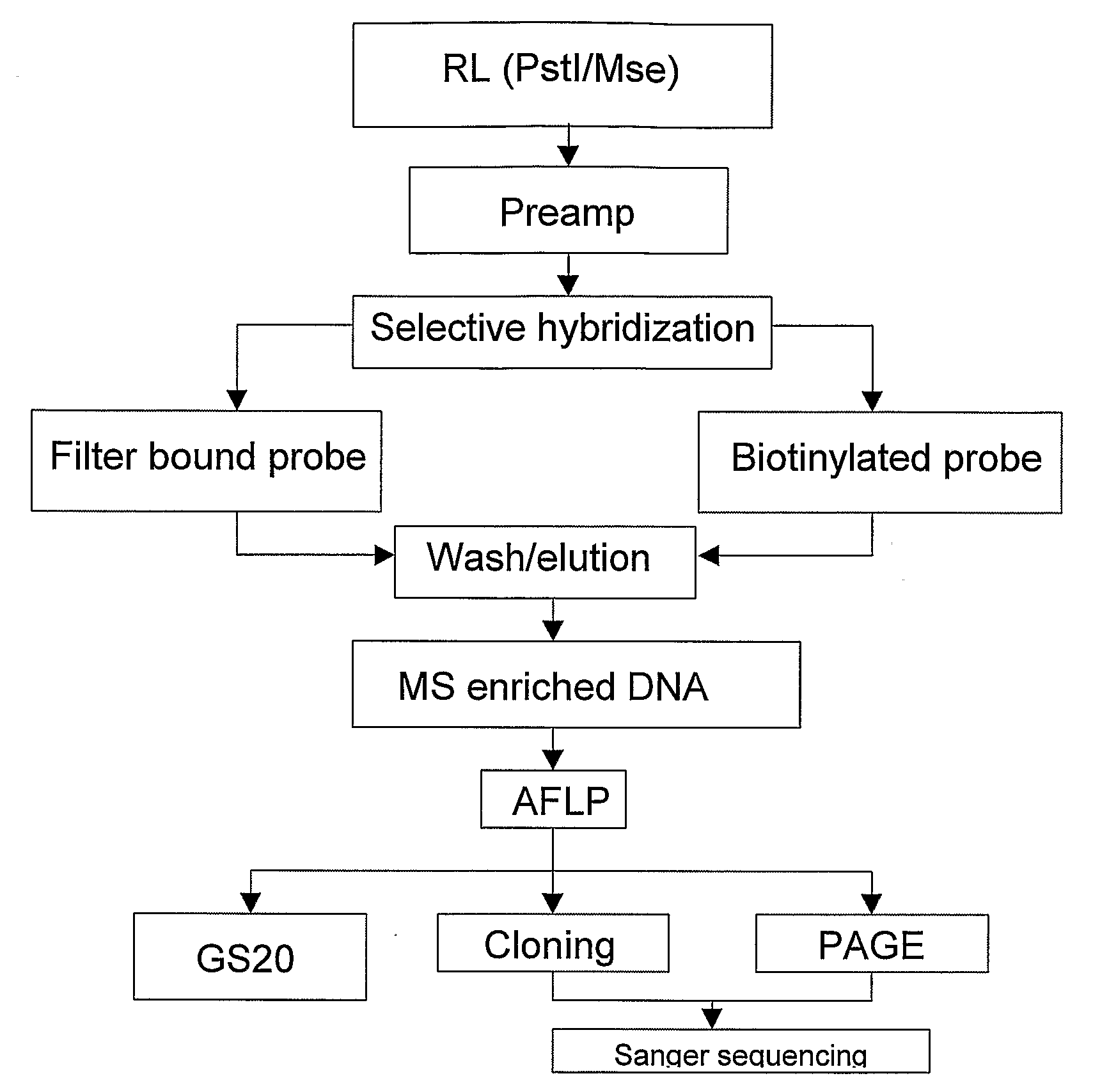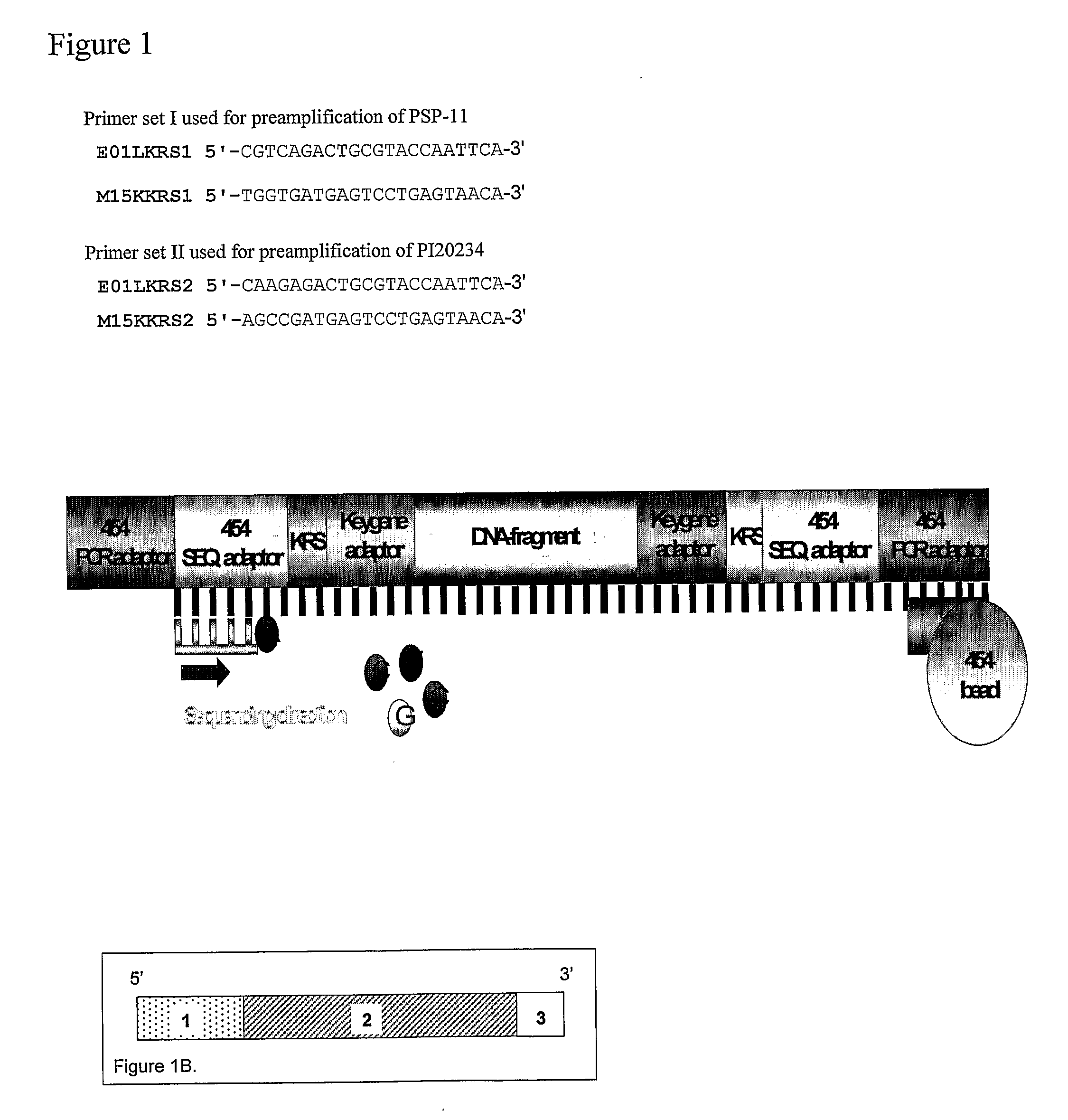Strategies for high throughput identification and detection of polymorphisms
- Summary
- Abstract
- Description
- Claims
- Application Information
AI Technical Summary
Benefits of technology
Problems solved by technology
Method used
Image
Examples
example 1
[0136]EcoRI / MseI restriction ligation mixture (1) was generated from genomic DNA of the pepper lines PSP-11 and PI20234. The restriction ligation mixture was 10 times diluted and 5 microliter of each sample was pre-amplified (2) with EcoRI +1 (A) and MseI +1 (C) primers (set I). After amplification the quality of the pre-amplification product of the two pepper samples was checked on a 1% agarose gel. The preamplification products were 20 times diluted, followed by a KRSEcoRI +1(A) and KRSMseI +2(CA) AFLP pre-amplification. The KRS (identifier) sections are underlined and the selective nucleotides are in bold at the 3′-end in the primer sequence SEQ ID 1-4 below. After amplification the quality of the pre-amplification product of the two pepper samples was checked on a 1% agarose gel and by an EcoRI +3(A) and MseI +3(C) (3) AFLP fingerprint (4). The pre-amplification products of the two pepper lines were separately purified on a QiagenPCR column (5). The concentration of the samples ...
example 2
Pepper
[0157]DNA from the Pepper lines PSP-11 and PI20234 was used to generate AFLP product by use of AFLP Keygene Recognition Site specific primers. (These AFLP primers are essentially the same as conventional AFLP primers, e.g. described in EP 0 534 858, and will generally contain a recognition site region, a constant region and one or more selective nucleotides in a selective region.
[0158]From the pepper lines PSP-11 or PI20234 150 ng of DNA was digested with the restriction endonucleases EcoRI (5 U / reaction) and MseI (2 U / reaction) for 1 hour at 37° C. following by inactivation for 10 minutes at 80° C. The obtained restriction fragments were ligated with double-stranded synthetic oligonucleotide adapter, one end of witch is compatible with one or both of the ends of the EcoRI and / or MseI restriction fragments. AFLP preamplification reactions (20 μl / reaction) with +1 / +1 AFLP primers were performed on 10 times diluted restriction-ligation mixture. PCR profile: 20*(30 s at 94° C.+60...
example 3
Maize
[0159]DNA from the Maize lines B73 and M017 was used to generate AFLP product by use of AFLP Keygene Recognition Site specific primers. (These AFLP primers are essentially the same as conventional AFLP primers, e.g. described in EP 0 534 858, and will generally contain a recognition site region, a constant region and one or more selective nucleotides at the 3′-end thereof.).
[0160]DNA from the pepper lines B73 or M017 was digested with the restriction endonucleases TaqI (5 U / reaction) for 1 hour at 65° C. and MseI (2 U / reaction) for 1 hour at 37° C. following by inactivation for 10 minutes at 80° C. The obtained restriction fragments were ligated with double-stranded synthetic oligonucleotide adapter, one end of witch is compatible with one or both of the ends of the TaqI and / or MseI restriction fragments.
[0161]AFLP preamplification reactions (20 μl / reaction) with +1 / +1 AFLP primers were performed on 10 times diluted restriction-ligation mixture. PCR profile: 20*(30 s at 94° C.+...
PUM
| Property | Measurement | Unit |
|---|---|---|
| Volume | aaaaa | aaaaa |
| Volume | aaaaa | aaaaa |
| Volume | aaaaa | aaaaa |
Abstract
Description
Claims
Application Information
 Login to View More
Login to View More - R&D
- Intellectual Property
- Life Sciences
- Materials
- Tech Scout
- Unparalleled Data Quality
- Higher Quality Content
- 60% Fewer Hallucinations
Browse by: Latest US Patents, China's latest patents, Technical Efficacy Thesaurus, Application Domain, Technology Topic, Popular Technical Reports.
© 2025 PatSnap. All rights reserved.Legal|Privacy policy|Modern Slavery Act Transparency Statement|Sitemap|About US| Contact US: help@patsnap.com



